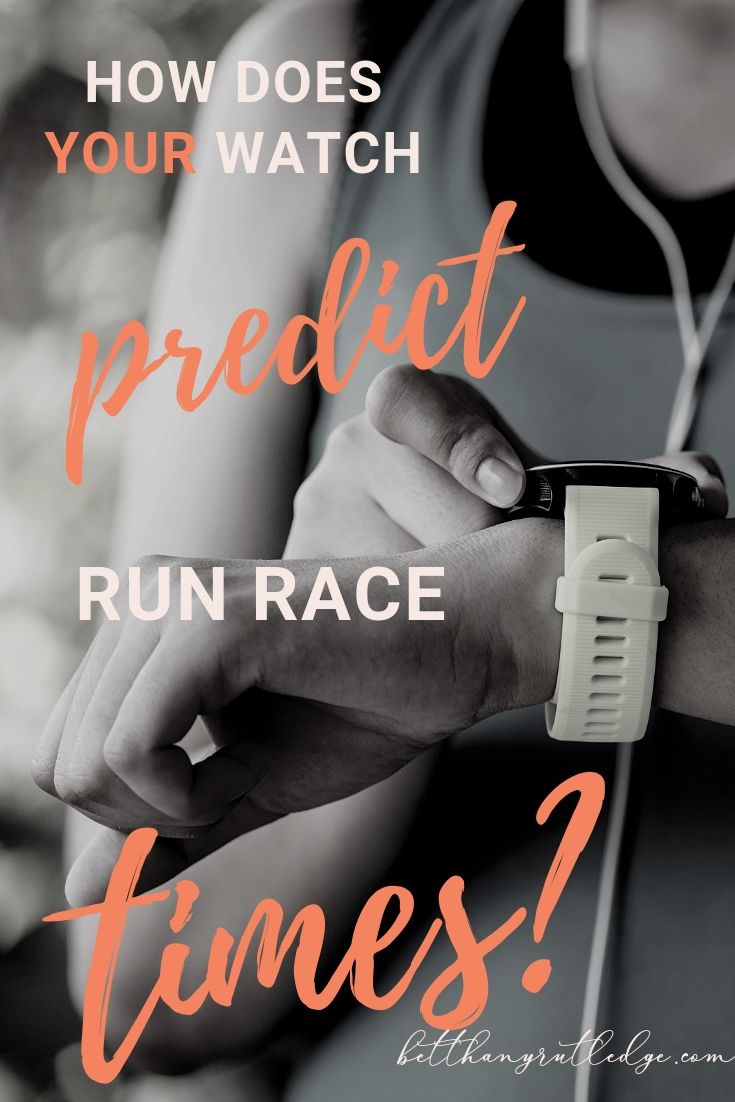How does Garmin race predictor work?

Your shiny new toy predicts how fast you’ll run your next 5k. But how does Garmin race predictor estimate your run race times, and are they accurate?
How Does Garmin Predict Run Race Times (And Are They Accurate)?
“I see my Garmin 920xt has a race prediction for running. I wonder what these are based on? My predictions are much faster than what I actually run. Anyone else see that?”
-confidentjellyfish (via Reddit)
If you have one of the newer Garmins you have no doubt seen (and possibly obsessed over) the Garmin Race Predictor. Perhaps your actual race times are slower or faster than the times that Garmin predicts you can do. But to satisfy our curiosity, let’s delve into how FirstBeat actually calculates these numbers
How does Garmin race predictor work: THE SHORT ANSWER
Step 1: Predict VO2 Max
Step 2: Reference a table of correlated running times versus VO2 values (such as the VDOT table found in Jack Daniels Running Formula)
How does Garmin race predictor work: THE LONGER ANSWER
Step 1: Calculate VO2 Max
Here is the method that FirstBeat uses to estimate VO2 Max according to their white paper on the subject.
The following calculation steps are used for VO2max estimation:
1) The personal background info (at least age) is logged
2) The person starts to exercise with a device that measures
heart rate and speed
3) The collected data is segmented to different heart rate
ranges and the reliability of different data segments is
calculated
4) The most reliable data segments are used for estimating the
person’s aerobic fitness level (VO2max) by utilizing either
linear or nonlinear dependency between the person’s heart rate and speed data.
Step 2: Reference a Table of VO2 Max Versus Running Speed Estimates
GARMIN RACE PREDICTOR LIMITATIONS
FirstBeat describes one important limitation in their method, that they use an age estimated max heart rate in their equation. They go on in further detail to describe a potential scenario in which the resulting value could vary as much as 9%. But they say that in most cases the margin of error falls within 5%.
Also different conditions could lead to different results. For example, heat, wind, and elevation will all affect your run speed which the equation relies upon. However, this limitation is somewhat mitigated by the fact that data is essentially gathered (and thus the result is being refined) nearly every time you go out for a run.
Read: When to run with pace versus heart rate
WHAT IF I’M RUNNING ON THE BEACH OR CONSTANTLY STOPPING?
One really neat feature of the FirstBeat method is that they automatically try to exclude certain situations from their calculation.
There are some situations in which the exclusion of data segments is necessary for reliable fitness level estimation. These automatically detected situations are, for example, running on soft ground, on a steep downhill, stopping at a traffic light (where the speed is zero but the heart rate is elevated), or the effect of cardiovascular drift (heart rate elevation) in long duration workouts
CAN I REALLY RUN THAT FAST?
One important obvious caveat besides the fact that there is a margin of error is that you have to be doing proper training specific to your race. Let’s say the race predictor estimates you can do a 20 minute 5k and a 3:15 marathon. If you’re only running 20 miles a week, going out at 3:15 pace during your marathon would be ridiculously reckless. Perhaps it’s best to think of these predictions as a lifetime goal, rather than an immediate goal.
Check out more on the FirstBeat white paper. Have a question you would like our coaches to answer? Comment below or send your questions by email.
Read: Worst running mistakes

Do you have any fun stories related to the Garmin race predictor feature? Be sure to let me know in the comments!
Want some virtual or in-person company on those long runs? Training is more fun with community. Check out Atlanta Tri Club for group training and Energy Lab for triathlon and swim coaching!
More Run Training Tips
- Find your runner personality [ to go faster]
- Top 4 worst new runner mistakes
- How does Garmin race predictor work?
- Essential Running Gear for Women
- The best 5k race strategy for all levels
- How to [really] improve your running

Hi, I’m Bethany–coach, author of Courage to Tri, 2x Kona qualifier, and twin mom. I believe if you have a body you’re an athlete. Grab my free 5k plan to start your own athletic journey.
Like this idea? Pin it!





2 Comments
Natalie · July 17, 2019 at 4:02 pm
I still don’t have garmin but I really need to invest and get one. This article is very informative. Thanks for sharing all the info.
Leslie · July 17, 2019 at 4:28 pm
Honestly, this technology is really quite impressive. Thanks for taking the time to explain this! So helpful!
Comments are closed.